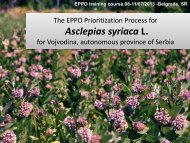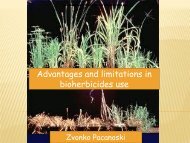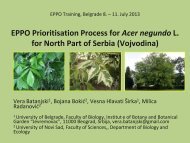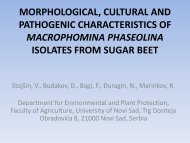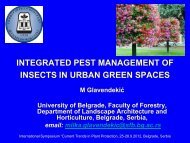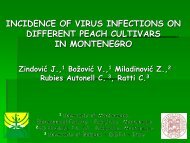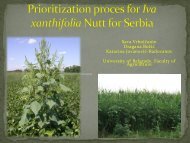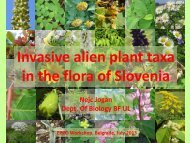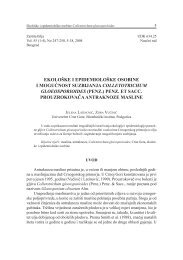ZAŠTITA BILJA PLANT PROTECTION
1 - Izbis
1 - Izbis
- No tags were found...
You also want an ePaper? Increase the reach of your titles
YUMPU automatically turns print PDFs into web optimized ePapers that Google loves.
36 Du{ica Deli} et al.<br />
mone production) and suppression of root diseases<br />
(Martinez-Viveros et al., 2010; Bhattacharyya and<br />
Jha, 2012). Strains with PGPR activity belonging<br />
mainly to phylum Proteobacteria: genera Azoarcus,<br />
Azospirillum, Azotobacter, Arthrobacter, Bacillus,<br />
Clostridium, Enterobacter, Gluconacetobacter,<br />
Pseudomonas, Serratia and rhizobial bacteria<br />
have been reported (Egamberdiyeva et al. 2004;<br />
Abbas-Zadeh et al. 2010; Antoun and Prévost 2000;<br />
Bhattacharyya and Jha, 2012). Due to ability of<br />
plant growth promotion, PGPR appeared as bacterial<br />
inoculants, a promising alternative for mineral<br />
and organic fertilization, pesticides and other supplements<br />
(Bhattacharyya and Jha, 2012).<br />
Barley (Hordeum vulgare L.) is a major cereal<br />
grain followed by legumes in crop rotation.<br />
One of an important advantage of using barley as<br />
cover crops is its trait to suppress weeds through<br />
physical as well as chemical allelopatic effects (Nagabhushana<br />
et al., 2001; Saini, 2006). Good cover<br />
crop, inexpensive and easy to grow barley should be<br />
considered an integral part of any farming system<br />
that wants to efficiently utilize nutrients, improve<br />
soil quality, and increase farm profitability mostly<br />
by reducing herbicide costs. Based on these characteristics<br />
barley is suitable preceding crop to legumes<br />
particularly, alfalfa. Inoculation of preceding crops<br />
with PGPR could help establishment of population<br />
of these bacteria in soil and rhizosphere of the next<br />
crop (Goos et al., 2001).<br />
In recent years there has been a growing interest<br />
in using bacterial inoculants as biofertilizers.<br />
Selection of effective strains with PGPR properties<br />
is one of the important steps in examination of potential<br />
bacterial inoculants. The experiment was<br />
designed to determine possibility of alfalfa growth<br />
promotion by inoculation of barley as preceding<br />
crop alfalfa with some rhizobacteria with the aim<br />
to select effective strains as biofertilizer applied in<br />
plant rotation.<br />
MATERIAL AND METHODS<br />
Sinorhizobium meliloti strain L3Si, Bacillus<br />
megaterium SNji, Enterobacter sp. strain E1 Azotobacter<br />
sp. strains A1 and A2, as well as Pseudomonas<br />
sp. strains P1 and P2 from the Collection of the Institute<br />
of Soil Science were used for the inoculation<br />
of barley. The inoculation effects of these PGPR on<br />
the yield of alfalfa cultivar K-28 as subsequent crop<br />
to barley were examined in pot experiment under<br />
greenhouse conditions.<br />
The pots were filled with 1.9 kg of non-sterile<br />
soil with following characteristics: pH (in H 2<br />
O) 7.4,<br />
0.09% N, 1.48% C, 21 mg kg -1 available P (P 2<br />
O 5<br />
) ,<br />
400<br />
mg kg -1 K 2<br />
O. The experiment was designed with 7<br />
inoculated treatments which represented alfalfa<br />
plants as subsequent crop grown in pots after cutting<br />
inoculated barley. Treatments were compared<br />
with two control treatments without inoculation:<br />
Ø (alfalfa plants after uninoculated preceding crop)<br />
and Øo (alfalfa without preceding crop). The experiment<br />
was carried out with 3 replications in completely<br />
randomised system and the pots were kept in<br />
greenhouse conditions. Bacillus and Enterobacter<br />
sp. strains and Pseudomonas sp. strains were cultivated<br />
for 24h in nutrient broth medium and King<br />
B medium, respectively (King et al., 1954; Vincent,<br />
1970; Bergey, 1984-1989; Sarić, 1989). S. meliloti<br />
strain was cultivated in yeast mannitol broth (YMB)<br />
for 48h while Azotobacter sp. strains were cultivated<br />
in N free mannitol broth with Vinogradsky solution<br />
for 72h .<br />
Barley (Hordeum vulgare L.) seeds were surfaced-sterilized<br />
with 0.1% HgCl 2<br />
solution (Vincent,<br />
1970) and inoculated (2 ml plant -1 of liquid culture)<br />
with single strains or with their mixture in a ratio<br />
1:1. Liquid culture of single strain contained >10 9<br />
cells ml -1 . Ten seeds per pot were planted and after 2<br />
weeks seedlings were thinned to 5 plants pot -1 . Barley<br />
plants were removed in filleting stage and alfalfa<br />
(Medicago sativa L.) as subsequent crop was sown<br />
in the same pots. Alfalfa seeds were surfaced-sterilized,<br />
planted and thinned as the same way like barley.<br />
The plants were kept for six weeks. Plant shoots<br />
were separated from roots and dried in an oven at<br />
70 ˚C to constant weight and the average dry weight<br />
per plant was calculated. The percentage of shoot N<br />
was determined from dried and ground plant samples<br />
using the CNS analyser and it was used to calculate<br />
total N content in mg per pot. The data were<br />
statistically processed by the LSD and Duncan test<br />
using the statistical program SPSS 10.0. Correlation<br />
coefficients were calculated to study the associative<br />
relations among the measured traits. All references<br />
to significance in the text imply statistical significance<br />
at P







